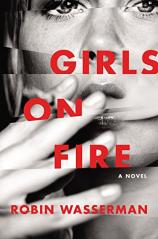Girls on Fire
Review
Girls on Fire
2016 is seeing a veritable plethora of young adult authors publishing novels intended for grownups. Jacqueline Woodson, Gayle Forman and Meg Rosoff are just a handful of authors who are writing for a more mature audience this year. Joining them is Robin Wasserman, who has written several popular and acclaimed novels for teens. In GIRLS ON FIRE, she continues to explore teenaged relationships and conflicts, but does so with a far darker tone.
GIRLS ON FIRE introduces us to high school junior Hannah Dexter, a hardworking “good girl” who is happy enough, she supposes, but lacks a close friend. Instead, she makes her way through high school with a handful of acquaintances, doing her best to avoid interactions with mean girl Nikki Drummond. Everyone in town is treating Nikki with kid gloves, though. After all, her boyfriend, Craig Ellison, recently killed himself.
"GIRLS ON FIRE illustrates, at times brutally, the powerful hold teenage girls’ friends and friendships can exert on their beliefs, their self-image, their entire lives."
No one can figure out why Craig, star athlete and all-around popular guy, would have gone out into the woods on the edge of town and shot himself in the head. There are plenty of theories, of course. It’s the early 1990s, and recently publicity of satanic cults (not to mention the new popularity of grunge music) has the adults of the small town of Battle Creek, Pennsylvania, on high alert for the moral safety of their young people.
Meanwhile, Hannah attracts the notice of relative newcomer Lacey Champlain, whose frank talk and devil-may-care attitude appeal to the more cautious Hannah. Lacey eagerly takes Hannah on as a project, remaking her in her own image, outfitted with Doc Martens, flannel shirts and her own Nirvana tapes. She even gives Hannah a new name: Dex. Lacey and Dex embark on an intense and possibly toxic friendship, until Lacey begins to reveal secrets that might push the two girls apart…or pull them even closer.
Wasserman effectively takes readers (at least those of a certain age) back to the early ’90s, suffusing Dex and Lacey’s story with the music, fashion and cultural preoccupations of the time. The novel is narrated in sections labeled “Us” and “Them.” The “Us” sections are told from the points of view of Lacey and Dex, while the “Them” sections take readers into the minds and memories of their mothers, grown women whose own girlhoods seem both like distant memories and continued influences on their present-day lives.
GIRLS ON FIRE illustrates, at times brutally, the powerful hold teenage girls’ friends and friendships can exert on their beliefs, their self-image, their entire lives. Readers will waver back and forth about whether Lacey’s influence on Dex’s life ultimately will be positive and transformative or negative, even toxic. This is a question that remains largely unanswered even at the novel’s close, making it ripe for ongoing contemplation and discussion.
Audiobook available; performed by Cassandra Campbell, Soneela Nankani and Allyson Ryan
Reviewed by Norah Piehl on May 20, 2016





